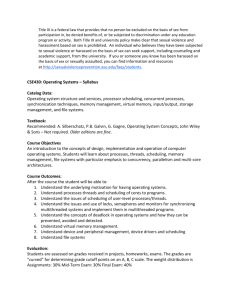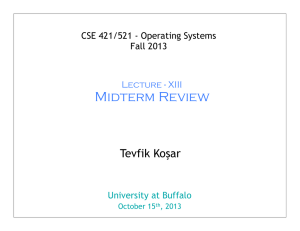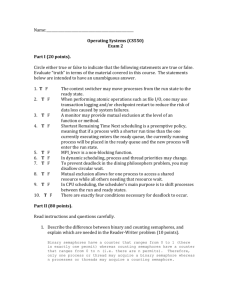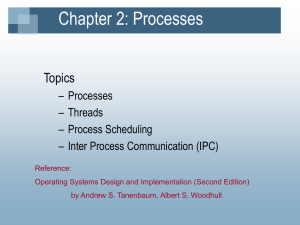Midterm Exam October 20th, Thursday 9:30am-10:50am @215 NSC
advertisement
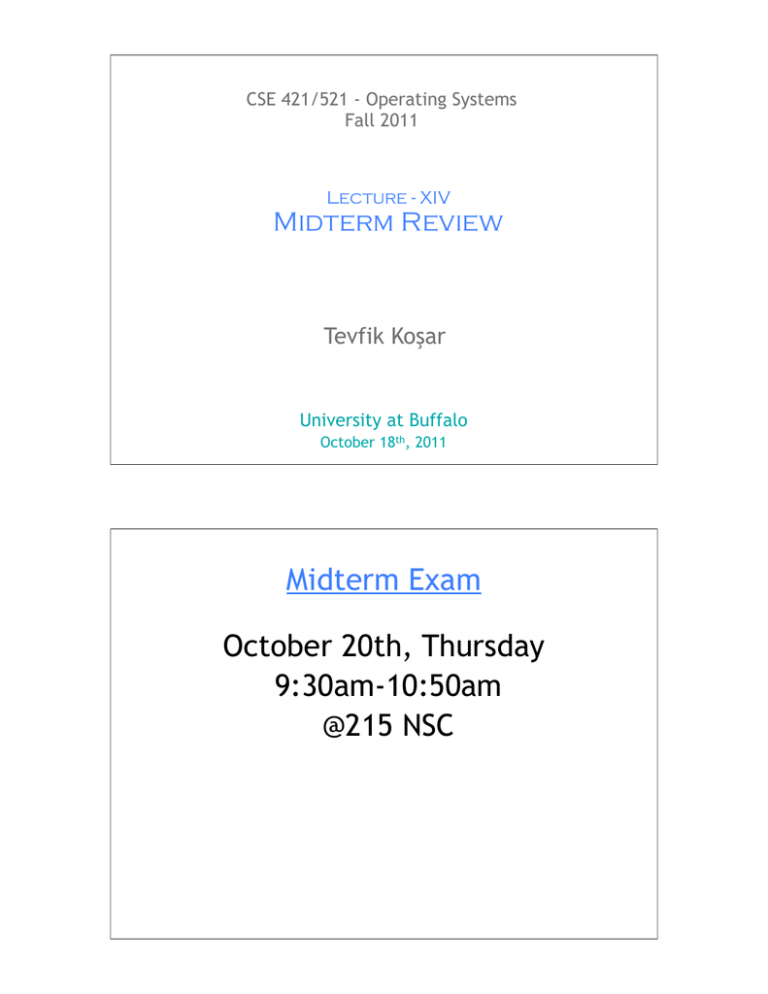
CSE 421/521 - Operating Systems
Fall 2011
Lecture - XIV
Midterm Review
Tevfik Koşar
University at Buffalo
October 18th, 2011
Midterm Exam
October 20th, Thursday
9:30am-10:50am
@215 NSC
1
Chapters included in the Midterm Exam
•
•
•
•
•
•
•
Ch.
Ch.
Ch.
Ch.
Ch.
Ch.
Ch.
1
2
3
4
5
6
7
(Introduction)
(OS Structures)
(Processes)
(Threads)
(CPU Scheduling)
(Synchronization)
(Deadlocks)
1 & 2: Overview
•
•
•
•
•
Basic OS Components
OS Design Goals & Responsibilities
OS Design Approaches
Kernel Mode vs User Mode
System Calls
4
3. Processes
•
•
•
•
•
•
Process Creation & Termination
Context Switching
Process Control Block (PCB)
Process States
Process Queues & Scheduling
Interprocess Communication
5
4. Threads
•
•
•
•
Concurrent Programming
Threads vs Processes
Threading Implementation & Multi-threading Models
Other Threading Issues
–
–
–
–
Thread creation & cancellation
Signal handling
Thread pools
Thread specific data
6
5. CPU Scheduling
• Scheduling Criteria & Metrics
• Scheduling Algorithms
– FCFS, SJF, Priority, Round Robing
– Preemptive vs Non-preemptive
– Gantt charts & measurement of different metrics
• Multilevel Feedback Queues
• Estimating CPU bursts
7
6. Synchronization
•
•
•
•
•
•
Race Conditions
Critical Section Problem
Mutual Exclusion
Semaphores
Monitors
Classic Problems of Synchronization
–
–
–
–
Bounded Buffer
Readers-Writers
Dining Philosophers
Sleeping Barber
8
7. Deadlocks
• Deadlock Characterization
• Deadlock Detection
– Resource Allocation Graphs
– Wait-for Graphs
– Deadlock detection algorithm
• Deadlock Avoidance
• Deadlock Recovery
9
Exercise Questions
10
Question 1
11
Solution 1
12
Solution 1 (cont)
13
Question 2
14
Solution 2
15
Question 3
16
Question 3 (cont)
17
Solution 3
18
Question 4
Which processor scheduling algorithm results in the shortest
average waiting time. Justify your answer.
19
Solution 4
Which processor scheduling algorithm results in the shortest
average waiting time. Justify your answer.
Answer: Shortest Job First (SJF), since moving a short
process before a long one decreases the waiting time of the
short process more than it increases the waiting time of the
long process. Consequently, the average waiting time
decreases.
20
Question 5
Explain why Round-Robin scheduling tends to favor CPU
bound processes over I/O bound ones.
21
Solution 5
Explain why Round-Robin scheduling tends to favor CPU
bound processes over I/O bound ones.
Answer: Each process gets put back at the end of the queue
no matter how much or how little of the quantum was used.
I/O bound processes tend to run for a short period of time
and then block which means they might have to wait in the
queue a long time.
22
Question 6
CPU scheduling quanta have remained about the same
over the past 20 years, but processors are now about
1,000 times faster. Why haven’t CPU scheduling quanta
changed?
23
Solution 6
CPU scheduling quanta have remained about the same
over the past 20 years, but processors are now about
1,000 times faster. Why haven’t CPU scheduling quanta
changed?
Answer: The length of the scheduling quanta is based on the
overhead of context switching a processor and the need to
move between processes within the time of human
perception. The overhead of context switching due to the
need to invalidate caches has remained relatively constant,
and the time of human perception has also not evolved much
in the past 20 years.
24
Question 7
List 4 events that might occur to cause a user process to be
context switched off the processor.
25
Solution 7
List 4 events that might occur to cause a user process to be
context switched off the processor.
Answer:
1.
Timer Interrupt (time for another process to run)
2.
Blocking to wait for another event (e.g. wait
system call)
3.
Process termination
4.
I/O Interrupt
26
Question 8
Assume S and T are binary semaphores, and X, Y, Z are
processes. X and Y are identical processes and consist of the
following four statements:
P(S); P(T); V(T); V(S)
And, process Z consists of the following statements:
P(T); P(S); V(S); V(T)
Would it be safer to run X and Y together or to run X and Z
together? Please justify your answer.
27
Solution 8
Assume S and T are binary semaphores, and X, Y, Z are
processes. X and Y are identical processes and consist of the
following four statements:
P(S); P(T); V(T); V(S)
And, process Z consists of the following statements:
P(T); P(S); V(S); V(T)
Would it be safer to run X and Y together or to run X and Z
together? Please justify your answer.
Answer: It is safer to run X and Y together since they request
resources in the same order, which eliminates the circular wait
condition needed for deadlock.
28
Question 9
Remember that if the semaphore operations Wait and Signal are not executed
atomically, then mutual exclusion may be violated. Assume that Wait and Signal are
implemented as below:
void Wait (Semaphore S) {
while (S.count <= 0) {}
S.count = S.count - 1;
}
void Signal (Semaphore S) {
S.count = S.count + 1;
}
Describe a scenario of context switches where two threads, T1 and T2, can both
enter a critical section guarded by a single mutex semaphore as a result of a lack of
atomicity.
29
Solution 9
Remember that if the semaphore operations Wait and Signal are not executed
atomically, then mutual exclusion may be violated. Assume that Wait and Signal are
implemented as below:
void Wait (Semaphore S) {
while (S.count <= 0) {}
S.count = S.count - 1;
}
void Signal (Semaphore S) {
S.count = S.count + 1;
}
Describe a scenario of context switches where two threads, T1 and T2, can both
enter a critical section guarded by a single mutex semaphore as a result of a lack of
atomicity.
Answer: Assume that the semaphore is initialized with count = 1. T1 calls Wait,
executes the while loop, and breaks out because count is positive. Then a context
switch occurs to T2 before T1 can decrement count. T2 also calls Wait, executes
the while loop, decrements count, and returns and enters the critical section.
Another context switch occurs, T1 decrements count, and also enters the critical
section. Mutual exclusion is therefore violated as a result of a lack of atomicity.
30
Question 10
31
Solution 10
+
32
Question 11
33
Question 11 (cont)
34
Solution 11
35
Question 11-b
36
Solution 11-b
37






